april 19th, 2008
David Nash
Ash Branch Cube, 1988-89
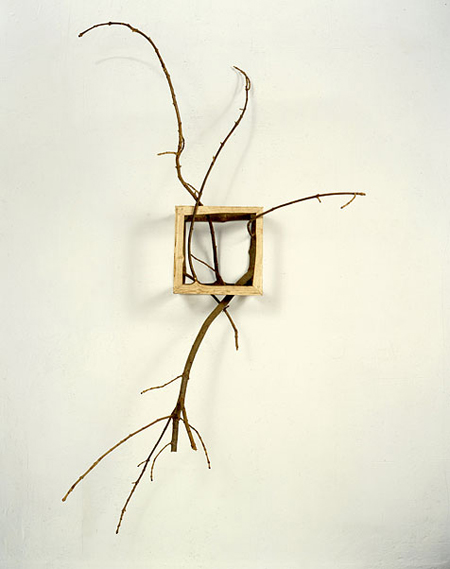
The Tree is central to David Nash’s art. He uses trees that have been felled for good reason and examines and selects them as the stone carver may choose blocks from different parts of a quarry. Nash also plants and trains trees, pruning and bending them to grow to preordained forms – the best known example being the Ash Dome, planted in 1977. Through grafting and periodic fletching (a method in which a trunk is bent by taking a notch out of the bark and heartwood at one side only) Nash has manipulated the trees so that they are beginning to meet to make a rounded canopy.
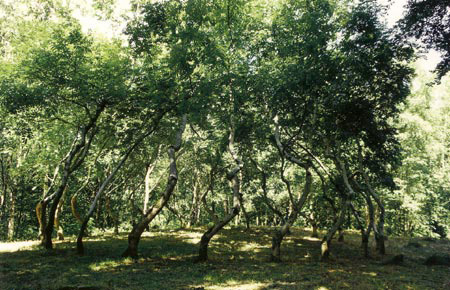
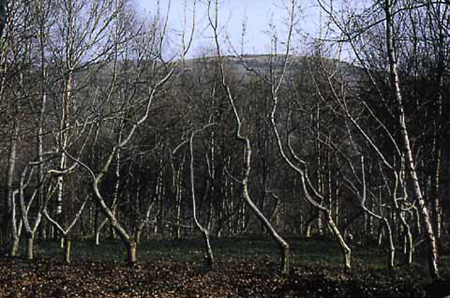
Guiseppe Penone
Elevazione, 2001
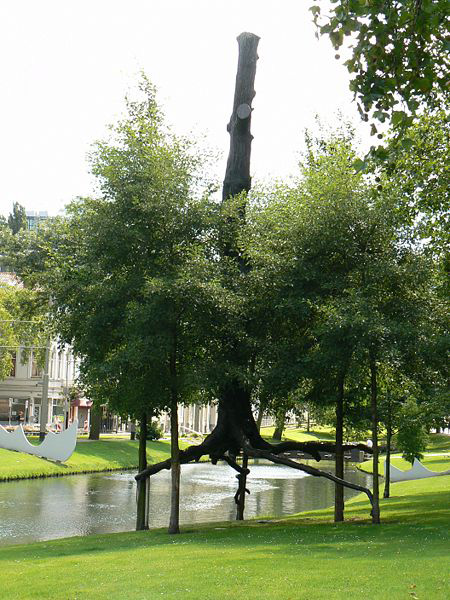
Posted in Dendrology, Visual Arts | Reacties uitgeschakeld voor Tree Torture
april 18th, 2008
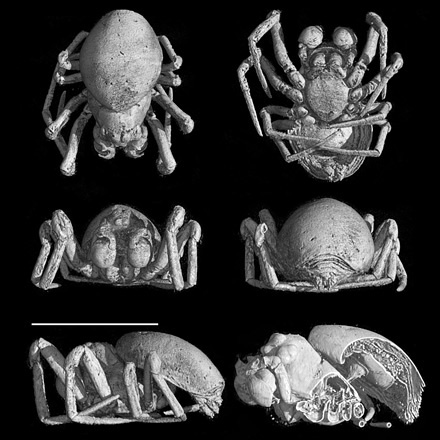
A 53-million-year-old spider has been revealed in exquisite detail by scientists from the UK and Belgium. The spider Cenotextricella simoni is about 1mm in length (see scale-bar). The scientists say that it would have inhabited a wooded area and lived in a warm climate. Internal details can be seen in the view at bottom-right.
The ancient creepy-crawly had been trapped in amber and preserved in a lowland area around Paris, France. The scientists reconstructed the creature’s original appearance using an X-ray-based medical imaging technique. The pictures, published in the journal Zootaxa, “digitally dissect” the tiny spider to expose amazing details such as the preservation of internal organs.
“This is definitely the way forward for the study of amber fossils,” said David Penney, from Manchester University and lead author on the study.
“Amber provides a unique window into past forest ecosystems. It retains an incredible amount of information, not just about the spiders themselves, but also about the environment in which they lived.”
This is the first time that the medical imaging technique, known as Very High Resolution X-Ray Computed Tomography, has been used to investigate a fossil in amber – and Dr Penney said it had the potential to “revolutionise” the way fossils were studied.
Posted in Arachnology | 2 Comments »
maart 26th, 2008
Tim Noble & Sue Webster
Real Life Is Rubbish, 2002
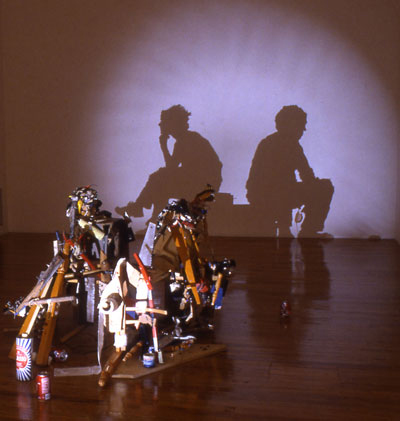
Tim Noble and Sue Webster. Partners in both life and art, Tim Noble (1966) and Sue Webster (1967) explore the toxic influences of consumer culture through new modes of portraiture. Turning garbage into complex and visually arresting sculptural installations, Noble and Webster exploit, manipulate and transform base materials, often using self-portraiture to undermine the “celebrated” authorship of the artist.
Dead White Trash (With Gulls), 1998, one of their earliest garbage pieces, is six months’ worth of peanut butter jars, soup cans, and other stuff from their kitchen rubbish can, plus a pair of dead seagulls. That it was the same six months it took to make the piece is more than a cute conceit. “As we were making it, we were eating and consuming,” says Noble. On the wall, the shadow figures of the artists take a break with a cigarette and a glass of wine. Real Life Is Rubbish, a recent work, is constructed from studio trash. “All our old tools,” explains Webster. “I was using a screwdriver, and it made my nose look great, so I used it. So we eventually ran out of tools.”
Dirty White Trash (With Gulls), 1998
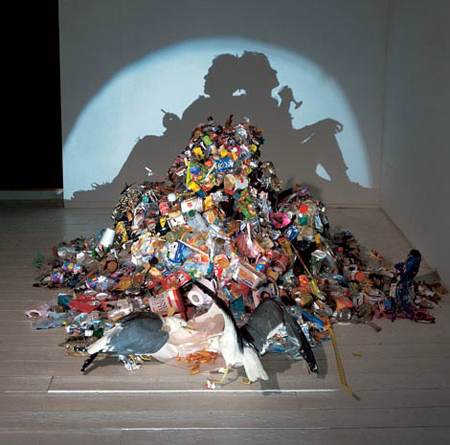
Diet Wiegman
Regarded from two sides, 1984
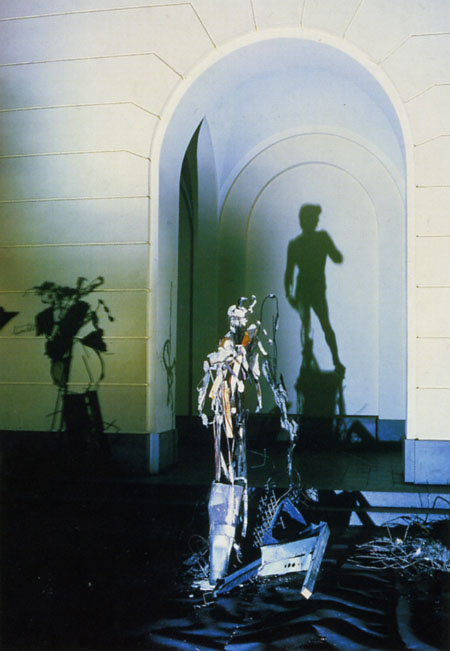
Shadow sculpture ©Diet Wiegman 1984
Posted in Archaeology, Ecology, Garbology, Visual Arts | 2 Comments »
maart 21st, 2008
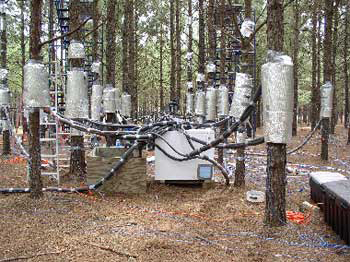
USDA Forest Service (FS) scientists have provided the first proof of concept for a method that allows researchers to study below-ground carbon allocation in trees without destroying them. In the latest issue of the journal Plant, Cell and Environment, Kurt Johnsen and fellow scientists at the FS Southern Research Station unit in Research Triangle Park, NC, describe a reversible, non-destructive chilling method that stops the movement of carbon into root systems.
The photosynthetic process of plants has been estimated to account for almost half of the carbon circulating in the Earth’s systems. Reliable data has been developed on carbon cycling in the above-ground processes of trees, but how much carbon is actually moved and stored below the ground has not yet been determined. Most methods to study below-ground processes involve destroying the roots as well as the mycorrhizal communities that live symbiotically with root systems.
Michael Sailstorfer
Waldputz (wood cleaning), 2000
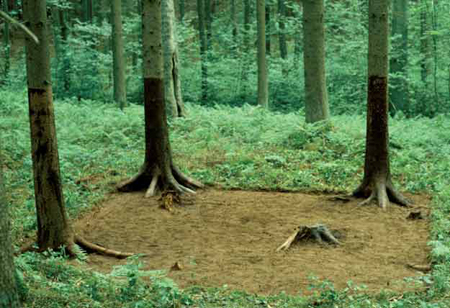
Mark Dion
A meter of Jungle, 1992
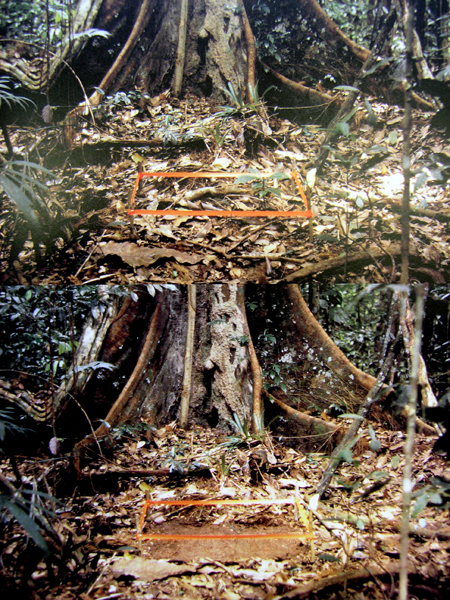
Posted in Dendrology, Visual Arts | Reacties uitgeschakeld voor Carbon Circulation
maart 18th, 2008
Dendrochronology or tree-ring dating is the method of scientific dating based on the analysis of tree-ring growth patterns. This technique was invented and developed during the 20th century originally by the astronomer A. E. Douglass, the founder of the Laboratory of Tree-Ring Research at the University of Arizona.
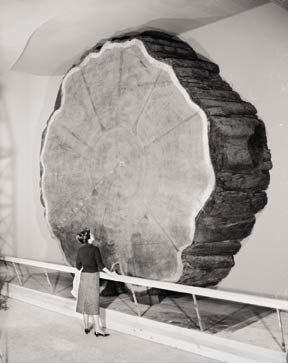
Other branches of Dendrology:
dendroarchaeology: The science that uses tree rings to date when timber was felled, transported, processed, or used for construction or wooden artifacts. Example: dating the tree rings of a beam from a ruin in the American Southwest to determine when it was built.
dendroclimatology: The science that uses tree rings to study present climate and reconstruct past climate. Example: analyzing ring widths of trees to determine how much rainfall fell per year long before weather records were kept.
dendroecology: The science that uses tree rings to study factors that affect the earth’s ecosystems. Example: analyzing the effects of air pollution on tree growth by studying changes in ring widths over time.
dendrogeomorphology: The science that uses tree rings to date earth surface processes that created, altered, or shaped the landscape. Example: analyzing changes in tree growth patterns via tree rings to date a series of landslide events.
dendroglaciology: The science that uses tree rings to date and study past and present changes in glaciers. Example: dating the inside rings of trees on moraines to establish the approximate date of a glacial advance.
dendrohydrology: The science that uses tree rings to study changes in river flow, surface runoff, and lake levels. Example: dating when trees were inundated to determine the sequence of lake level changes over time.
dendropyrochronology: The science that uses tree rings to date and study past and present changes in wildfires. Example: dating the fire scars left in tree rings to determine how often fires occurred in the past.
dendroentomology: The science that uses tree rings to date and study the past dynamics of insect populations. Example: dating the growth suppressions left in tree rings from western spruce budworm outbreaks in the past.
Helgi Hjaltalins Ejolfsdorfs
Dig down Dig up, 2004
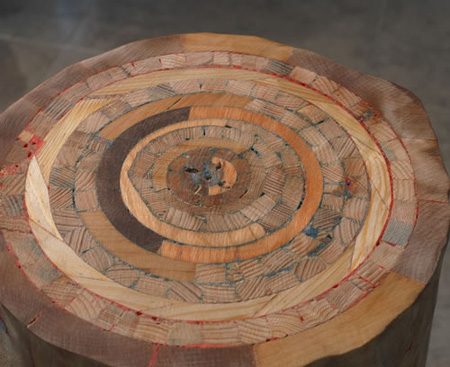
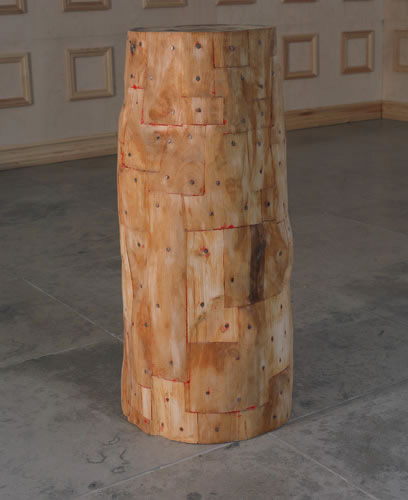
Made for the Sculpture Quadrennial Riga 2004 – European Space
Posted in Dendrology, Visual Arts, Xylology | 2 Comments »
maart 12th, 2008
Cornelia Parker
Cold Dark Matter: An Exploded View, 1991
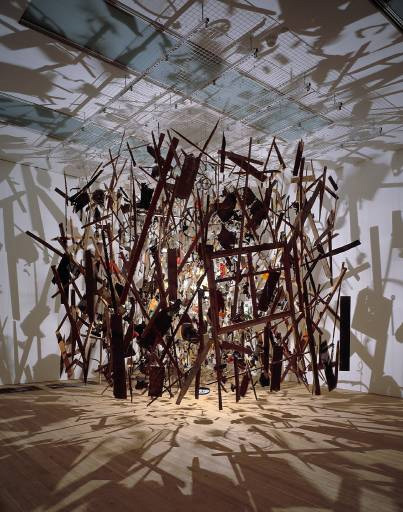
Cold Dark Matter began life as a garden shed filled with objects from her own and friends’ sheds and things bought at a car boot sale. She then asked the army to blow up the shed under very controlled conditions. The objects, along with the fragments of the shed, were collected and suspended in a closed room in an attempt to recreate the moment just after the explosion. The installation is lit with a single light-bulb at the very centre of the arrangement, casting shadows on the walls. The title gives us a whole new way of understanding the artwork, making us think of other dramatic moments of destruction and creation in the much wider universe.
Neither From Nor Towards, 1992
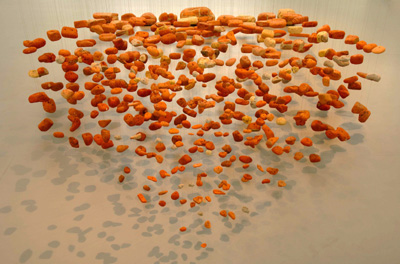
In ‘Neither From Nor Towards’ the brick remnants of an eroded house hang suspended in stilled animation in the work of British artist Cornelia Parker, who was nominated for the Turner prize in 1997. Her work often depicts a moment in time, which has been halted. In ‘Neither From Nor Towards’, the bricks are resonant with their previous life, reminding us of the passage of time over which we have no control. Parker rescues and reinterprets the ordinary, which is transformed by the gallery setting into something poetic and extraordinary.
Heart of Darkness, 2004
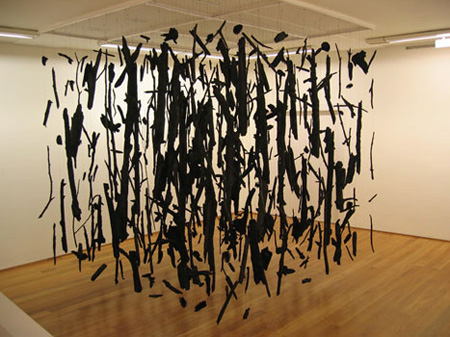
Charcoal from a Florida Wildfire (planned forest burn that got out of control)
Cornelia Parker was born in Cheshire in I956 and lives and works in London. She is interested in how everyday objects can be changed by (often violent) processes. During her career she has used a steamroller to flatten silver plates and has transformed a wedding ring into metres of fine, gold thread. Although at first glance it might seem that she is interested in destroying objects, she is in fact fascinated by how change can create something completely new.
Posted in Archaeology, Cosmology, Eschatology, Pyrography, Visual Arts | Reacties uitgeschakeld voor Cold Dark Matter
maart 11th, 2008
Tony Cragg
Stack, 1975
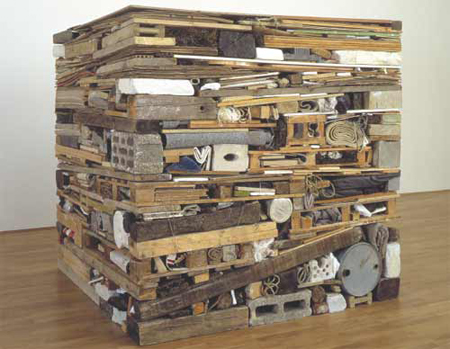
Many of Cragg’s early works are made from found materials and discarded construction materials and disposed household materials. This gave him a large range of mainly man-made materials and automatically provided him with the thematic concerns that became characteristic of his work up to the present. During the 1970s he made sculptures using simple making techniques like stacking, splitting and crushing. In 1978 he collected discarded plastic fragments and arranged them into colour categories. The first work of this kind was called ‘New Stones-Newtons Tones’. Shortly after this he made works on the floor and wall reliefs which created images. One of these works , Britain Seen From the North (1981), features the shape of the island of Great Britain on the wall, oriented so that north is to the left. To the left of the island is the figure of a man, apparently Cragg himself, looking at the country from the position of an outsider.
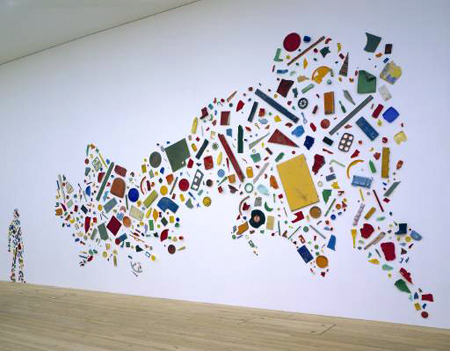
Britain Seen From the North, 1981
Posted in Archaeology, Ecology, Garbology, Visual Arts | 2 Comments »
maart 10th, 2008
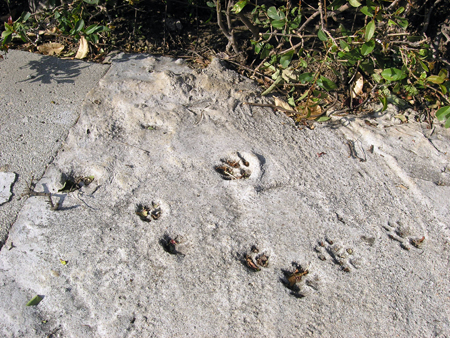
2008 AD, concrete sidewalk, Hollywood, USA
Smallest breed of dog, 15 cm/10 in high, developed in the USA from Mexican origins. It may weigh only 1 kg/2.2 lb. The domed head and wide-set ears are characteristic, and the skull is large compared to the body. It can be almost any colour, and occurs in both smooth (or even hairless) and long-coated varieties.
Posted in Archaeology, Mammalogy | Reacties uitgeschakeld voor Chihuahua Footprints Discovered!
maart 6th, 2008
‘Everybody’s plastic, but I love plastic. I want to be plastic.’ – Andy Warhol
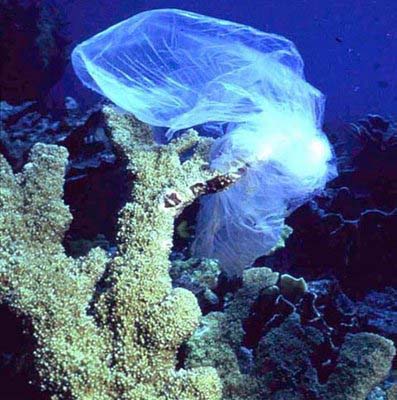
A “floating landfill, made up of plastic particles is swirling in a convergence zone about 30 to 40 degrees north latitude and 135 to 145 west longitude. It’s about 1,000 miles west of California and 1,000 miles north of the Hawaiian Islands — a week’s journey by boat from the nearest port. The trash collects in one area, known as the North Pacific Gyre, due to a clockwise trade wind that circulates along the Pacific Rim. While the plastic trash floats along, instead of biodegrading, it is “photodegrading,” — the sun’s UV rays turn the bottle brittle, much like they would crack the vinyl on a car roof. They break down the bottle into small pieces and, in some cases, into particles as fine as dust.
Charles Moore, the marine researcher at the Algalita Marina Research Foundation in Long Beach who has been studying and publicizing the patch for the past 10 years, said the debris — which he estimates weighs 3 million tons and covers an area twice the size of Texas — is made up mostly of fine plastic chips and is impossible to skim out of the ocean. Also, it’s undetectable by overhead satellite photos because it’s 80 percent plastic and therefore translucent. The plastic moves just beneath the surface, from one inch to depths of 300 feet, according to samples Moore collected on the most recent trip. (1)
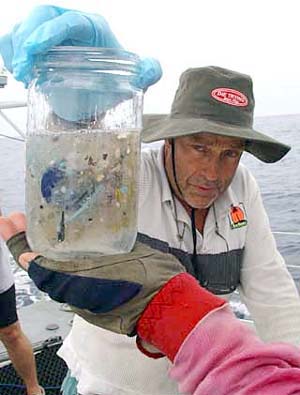
Ironically, the debris is re-entering the oceans whence it came; the ancient plankton that once floated on Earth’s primordial sea gave rise to the petroleum now being transformed into plastic polymers. That exhumed life, our “civilized plankton,” is, in effect, competing with its natural counterparts, as well as with those life-forms that directly or indirectly feed on them. Inside the North Pacific Gyre the natural plankton is outnumbered 6 to 1 in favor of the plastic plankton. The large ratio of plastic to plankton found in this study has the potential to affect many types of biota. Most susceptible are the birds and filter feeders that focus their feeding activities on the upper portion of the water column. Many birds have been examined and found to contain small debris in their stomachs, a result of their mistaking plastic for food
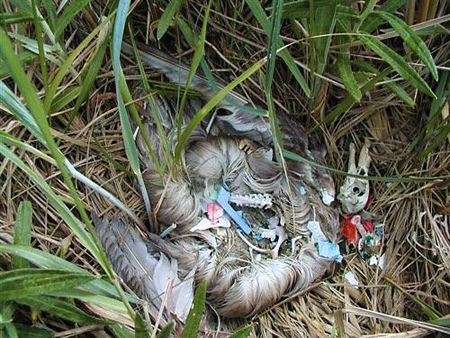
Worldwide, 82 of 144 bird species examined contained small debris in their stomachs, and in many species the incidence of ingestion exceeds 80% of the individuals.
The scale of the phenomenon is astounding. Plastic debris in now the most common surface feature of the world’s oceans. Because 40 percent of the oceans are classified as subtropical gyres, a fourth of the planet’s surface area has become an accumulator of floating plastic debris. What can be done with this new class of products made specifically to defeat natural recycling? How can the dictum “In ecosystems, everything is used” be made to work with plastic? (2)
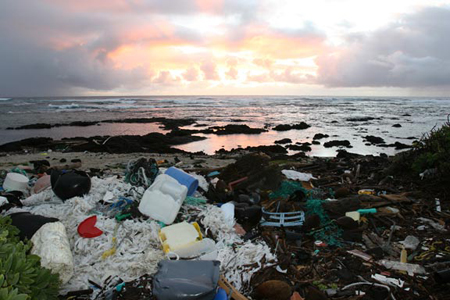
(1) Based on a text by Justin Berton / San Francisco Chronicle
(2) Based on a text by Charles Moore
Posted in Ecology, Oceanography, Zoology | 4 Comments »
maart 3rd, 2008
La Brea Tar Pits, Los Angeles
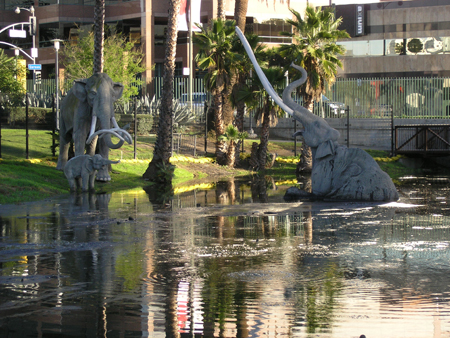
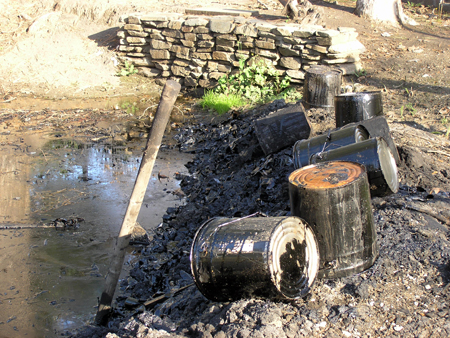
Rancho La Brea is one of the world’s most famous fossil localities, recognized for having the largest and most diverse assemblage of extinct Ice Age plants and animals in the world. Radiometric dating of preserved wood and bones has given an age of 38,000 years for the oldest known material from the La Brea seeps, and they are still ensnaring organisms today.
The Page Museum is located next to the Rancho La Brea Tar Pits in the heart of Los Angeles. Through windows at the Page Museum Laboratory, visitors can watch bones being cleaned and repaired. Outside the Museum, in Hancock Park, life-size replicas of several extinct mammals are featured.
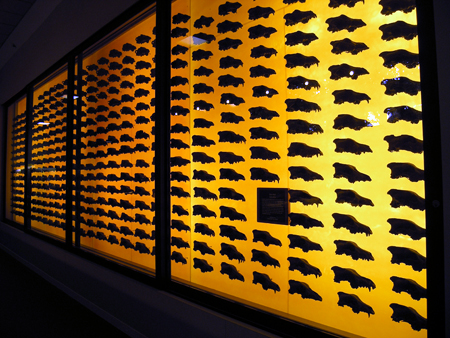
Sculs of the saber-toothed cat, Page Museum Los Angeles, 2008
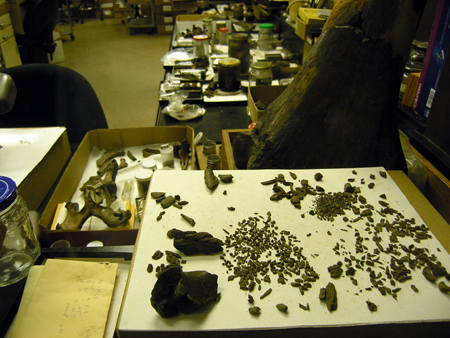
La Brea Tar Pits lab, Page Museum Los Angeles, 2008
The collections document the Rancho La Brea biota and include some 3.5 million specimens representing over 600 species of animals and plants. The site-specific collections also include geological samples, archaeological artifacts and historical objects. The Tar Pits function as black wormholes where the past gets mingled with the future. Every day object from the past come up and new once from the present disappear inside the pits to be discovered by the next generation archaeologists. Every sample will be washed and cleaned and puzzled back together again in order to understand the future past.
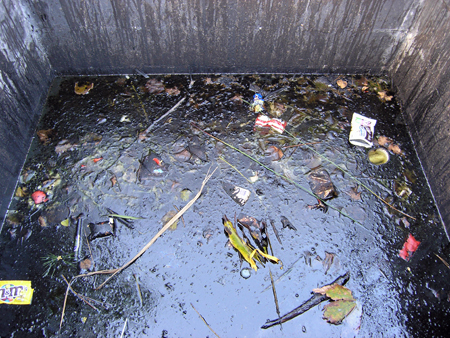
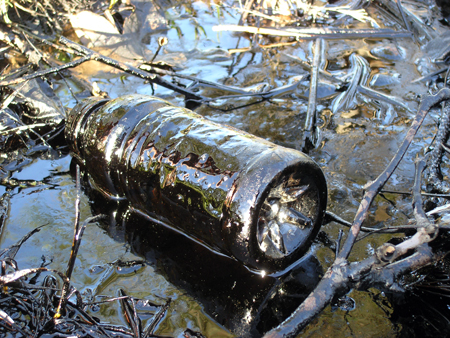
Posted in Ecology, Geology, Paleontology | Reacties uitgeschakeld voor Paleontologic Time Travel
februari 24th, 2008
Christine and Margaret Wertheim
“Crochet Coral and Anemone Garden” with sea slug by Marianne Midelburg.
Photos by Alyssa Gorelick.
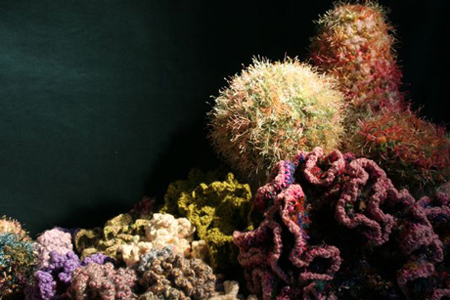
The Institute For Figuring is crocheting a coral reef: a woolly celebration of the intersection of higher geometry and feminine handicraft, and a testimony to the disappearing wonders of the marine world.
One of the acknowledged wonders of the natural world, the Great Barrier Reef stretches along the coast of Queensland like a psychadelic serpent, a riotous profusion of color and form unparalleled on our planet. But global warming and pollutants so threaten this fragile monster that scientists now believe the reef will be devastated in coming years. As a homage to the Great One, IFF co-directors Margaret and Christine Wertheim – who grew up in Queensland – have instigated a project to crochet a woolen reef. Using the techniques of hyperbolic crochet discovered by mathematician Dr. Daina Taimina in 1997, the Institute has been evolving a wide taxonomy of reef-life forms – loopy “kelps”, fringed “anemones”, and curlicued “corals.” While the process that brings these models into being is algorithmic, endless permutations of the underlying formulae result in a constantly surprising panoply of shapes. The quality of yarn, style of stitch and tightness of the crochet all affect the finished model so that each is as individual as a living organism. As a whole, the Crochet Reef is made up of various different “sub-reefs,” each with its own colors and styling: there is the Red Reef, the Blue Reef, the Bleached Reef, the Branched Anemone Garden, and our largest work, The Ladies’ Silurian Atoll, a ring-shaped installation with close to 1000 individual crochet forms made by dozens of contributors from around the world. In addition to these woolen sub-reefs is the massive Toxic Reef, crocheted from yarn and plastic trash.
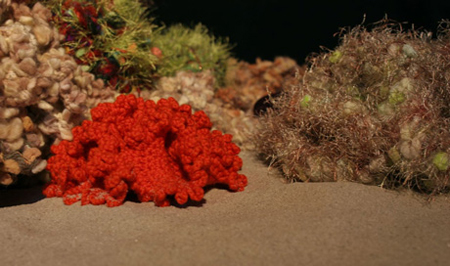
Posted in Ecology, Visual Arts | Reacties uitgeschakeld voor Coral Crocheting
februari 23rd, 2008
Panamarenko
Hofkes (little gardens), 1967
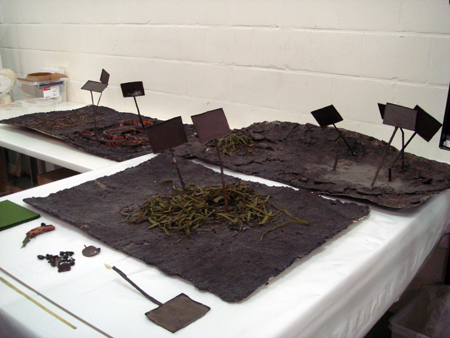
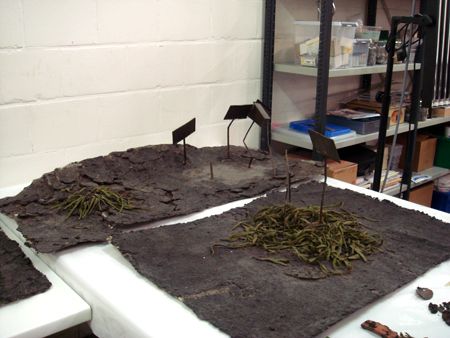
Hofkens is a collection of three samples (cut outs) of industrial gardens containing only artificial materials. Nature is being reconstructed without any natural materials. The title refers to the small city-gardens people use to grow vegetables and herbs. The work is currently being restored in SMAK, the Municipal Museum of Contemporary Art in Ghent.
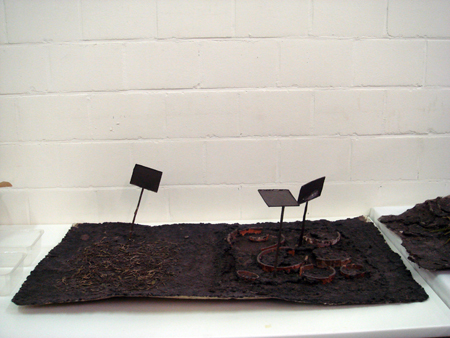
Posted in Archaeology, Ecology, Visual Arts | Reacties uitgeschakeld voor Industrial Gardening
december 4th, 2007
Maarten Vanden Eynde
Vondelpark Amsterdam, winter 1999
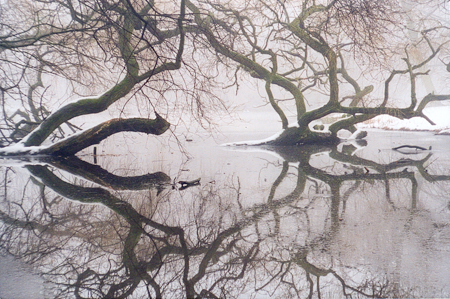
www.maartenvandeneynde.com
Posted in Dendrology, Visual Arts | 1 Comment »
november 26th, 2007
Mark Dion
Lab Bench, 2006
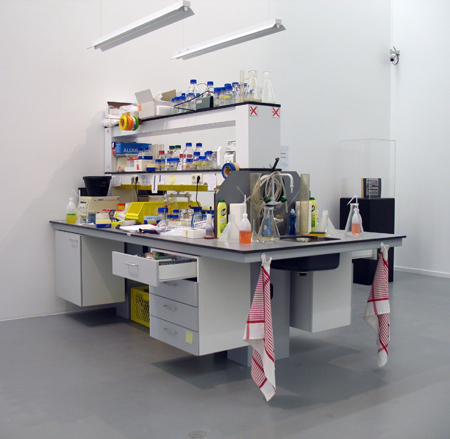
photo: D. Rijper
Mark Dion conducts large-scale projects in which he questions the role of specialists—from archaeologists to ethnologists, from historians to art curators. He questions the classification systems placed on objects by professionals and institutions and invites viewers of his work to be an active audience. Lab Bench is Mark Dion’s perfect imitation or ‘clone’ of the biotechnology laboratory Hubrecht in Utrecht. Could it be used to clone cells? Did he clone a cloning lab? That would be brilliant!
A fictive line separates the bench and literary copies everything form the other ‘original’ side, including personal family photo’s in the open drawer and a left over toast on the table with one bite missing. The work was part of the exhibition Genesis – Life at the end of the information age in the Centraal Museum Utrecht (14/04 – 12/08/2007).
Posted in Biology, Visual Arts | Reacties uitgeschakeld voor Clone the Clone
november 22nd, 2007
Boryana D Rossa
Clone, 1997

A clone is an identical copy, and thus may be thought to be perfectly predictable (after all we understand the original), but this is a big error. The world is not static but dynamic and thus evolution must be taken into account. Each organism occupies a different space and thus will enjoy different experiences. These lead to changes in the organism itself, chemical, electrical, valuational, etc. which will very rapidly diverge the behaviours of clones (as we see from studies of identical twins). Despite the human desire for predictabilty, this chaos driven divergence is endemic to our coevolutionary world and makes the simplistic predictions of the perpetrators of these ‘improvements’ nonsensical.
In complex systems, plans are simply delusions…
CALResCo promotes free world-wide education about Complex Systems
Posted in Biology, Philosophy, Visual Arts | Reacties uitgeschakeld voor The Art of Cloning





































